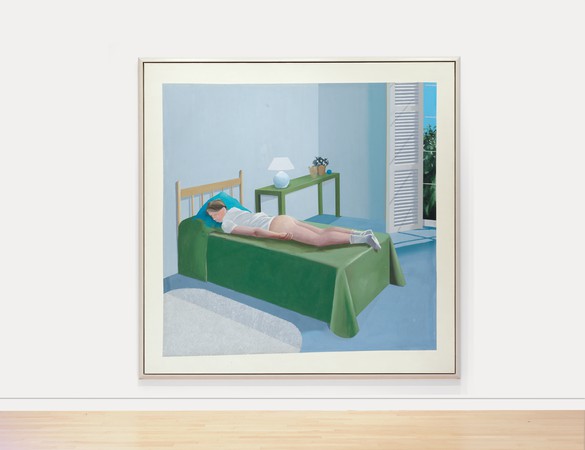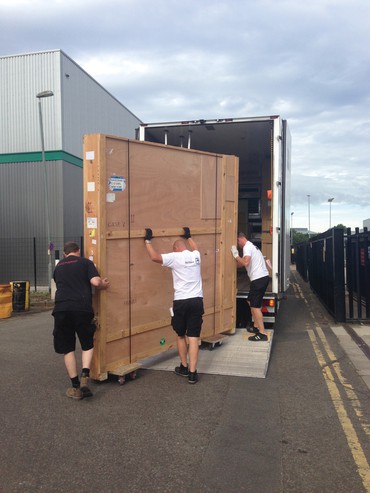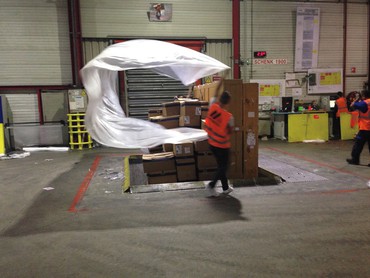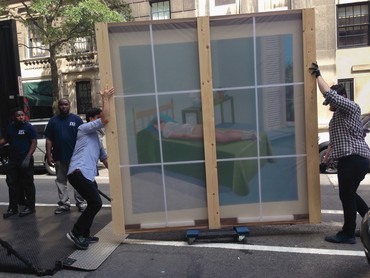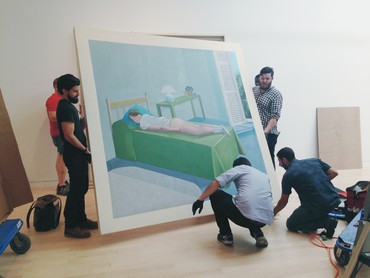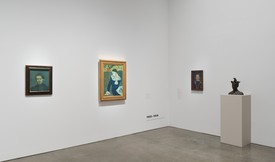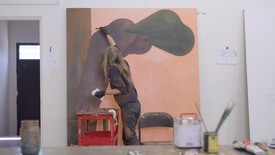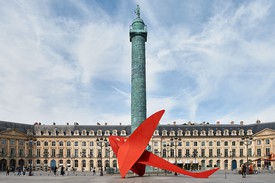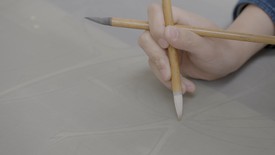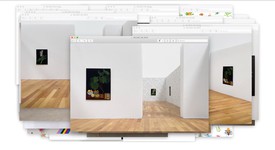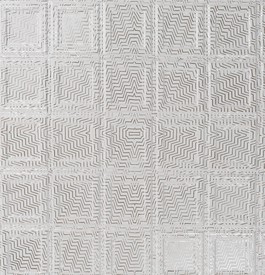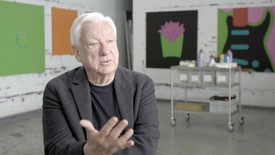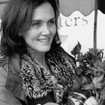
A writer, filmmaker, broadcaster, and food entrepreneur, Susan Ellicott travels frequently between the US and London on assignment. A former on-air correspondent for the BBC, ABC News, and NPR, she recently appeared in a series of Japanese television films on artisan food in Japan. Last year she worked as a filmmaker for Stanford University and as a judge of chef cook-offs at crab and abalone festivals in Mendocino.
08:00
Monday, September 19, 2016
West London, On a count of three, two tall strong men in gloves and reinforced boots roll a ten-foot-tall crate out of a hangar on an industrial estate. They make it look easy, but this is highly specialized work: in the crate is an irreplaceable work of art, The Room, Tarzana (1967), a painting by David Hockney on loan from its owner to Gagosian Madison Avenue for a show that will open within days.
The men arrived from Amsterdam a half hour ago. Employed by one of Europe’s top art-moving companies, they’ve driven through the night and taken a ferry across the English Channel. Now—with me traveling along as a courier to witness every step—they’re about to return by a slightly different route.
You might assume that a painting, like people, would fly direct between the major art capitals of London and New York, but artworks this size are too big for the standard cargo services at London’s Heathrow Airport. The only way to get Tarzana to Manhattan in time to appear as a key piece in Madison Avenue’s Nudes show, alongside works by Pablo Picasso, Henri Matisse, and Amedeo Modigliani, is to truck it via the Channel Tunnel from England to France and then by road to the Belgian city of Liège, where it will board a dedicated cargo-only 747 at a specialist freight airport.
For insurance purposes—even though the truck will be tracked by satellite—a courier must go along. So here I am.
08:30
The drivers triple-strap the crated painting and, in a separate crate, its boxed-up frame to the side panels inside one of the trailers they’re hauling. The other contains art headed to Frankfurt and Basel. Click—they padlock the rear door and pull up a security bar. Off we go, dwarfing every vehicle on the road.
10:30
Dover, We pull into the parking lot at the port of Dover. A customs official tells us it’s a “30 minute” wait. The drivers look skeptical—last week they waited eight hours. In a spartan lounge overlooking the English Channel and the famous not-so-white cliffs of Dover, we wait with drivers of trucks carrying goods between the United Kingdom, Poland, Spain, Bulgaria, France, and Germany. I take a seat with a view of the truck. The drivers fuel up on coffee and cigarettes.
13:30
Finally, after three hours, we get clearance and drive nine miles back inland to the Channel Tunnel entry point for passport and security checks.
14:40
After a full x-ray of the truck, we descend a ramp rimmed by electric fences and barbed wire and drive onto a cargo train.
16:00
A shuttle takes the drivers to a passenger car. A Bulgarian insists on standing up to give me his seat. Everyone sits in silence or nods off for the thirty-minute undersea journey. A single female co-driver and I are the only women.
18:00
Calais, One hour later, but two hours on the clock given the one-hour time difference between England and France, we arrive in the French port of Calais. Setting off toward Liège, the Dutch drivers snack on peanut butter sandwiches and yogurts. One takes a nap on a bed in the cabin while the other drives. Through the wrap-around windshield I get a panoramic view of French, then Belgian fields, villages, and church towers from my cabin seat.
22:00
Liège, Navigating in the dark around a tiny traffic circle, our driver pulls the truck into the airport forecourt. We go through a passport check and put on high-vis vests. The driver reverses into an unloading bay, micro-adjusting the position of the truck’s rear doors with the help of hydraulics so that they open seamlessly into a giant hangar.
Men in overalls clock onto their night shifts, greeting each other with a Belgian-style single kiss on the cheek. A team rolls the crates onto a pallet set in the floor.
22:30
The air smells of hay and horses: twelve elite show-jumpers are waiting to fly on the same 747 as Tarzana. A forklift driver stacks cardboard boxes of jeans around the artwork’s crate to give it stability on the pallet and build a shape to fit the curve of the plane’s interior.
23:00
He binds the load with industrial plastic film and a net for added security.
23:30
The sealed load is sent by conveyor belt to a storage area.
24:00
I get to my airport hotel and set my alarm for 02:15.
02:45
Tuesday, September 20
An agent picks me up and returns me to the airport hangar after another passport and security check.
03:00
I sit on a pallet and drink a vending-machine hot chocolate.
03:30
Outside, a 747 flown by the freight company TNT Express is waiting, its gutted belly a trellis of computerized metal tracks that slide cargo into place hands free. A yellow X-shaped crane works like a massive pair of scissors to raise pallets of cargo into the hold from a line of waiting trucks.
04:00
On go refrigerated medicines and high-value electrical goods.
04:30
Last in are the Hockney and the horses, sedated to minimize their stress.
04:45
The horses’ two grooms and I climb a flight of metal steps leading to the nose of the plane. There are no flight attendants, just two pilots. Behind the tiny galley and its coffee machine are six seats and a cabin with two beds. The pilots deliver a safety briefing and point out an ejector hatch and metal “ropes” we must hang onto for dear life to break our fall if we should eject.
05:00
Take-off feels slow and magical. As one of the pilot explains, “We’re 360 tonnes fully loaded. We don’t make sudden movements.”
05:05
We climb over the lights of Liège, away from the breaking dawn, against the customary flow of passenger aircraft flying eastward from the United States to Europe.
Partway over the Atlantic I take coffee to the pilots, who are eating M&Ms.
07:00
We land at JFK in perfect sunshine. I clear immigration and wait beneath the wing of the aircraft to watch Tarzana unloaded onto a flatbed truck and whisked to the other side of the airport to clear customs.
09:00
A ground agent picks me up in his black SUV and we meet a duo of art handlers who load the painting and its frame into an empty truck.
10:00
The agent in his SUV follows the truck into Manhattan, waving his ID pass to police at traffic lights to avoid getting separated.
12:00
We reach Madison Avenue. Gagosian staff arrive to direct the unloading, unpacking, and carrying of the artwork into the gallery.
13:00
The “placeholder” for Tarzana is replaced by the real thing.
Artwork © David Hockney. Photo by Rob McKeever. Timeline photos by Susan Ellicott
